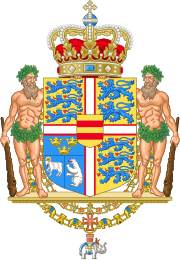
Back دستور الدنمارك Arabic Канстытуцыя Даніі Byelorussian Danmarks Riges Grundlov Danish Grundgesetz Dänemarks German Σύνταγμα της Δανίας Greek Konstitucio de Danio Esperanto Constitución de Dinamarca Spanish Taani põhiseadus Estonian قانون اساسی دانمارک Persian Constitution danoise de 1953 French
| Constitutional Act of the Realm of Denmark | |
|---|---|
 Front page of the first constitution from 1849 | |
| Overview | |
| Original title | Danmarks Riges Grundlov |
| Jurisdiction | Denmark, incl. Greenland and the Faroe Islands |
| Ratified | 25 May 1849 (first) 28 May 1953 (current) |
| Date effective | 5 June 1849 (first) 5 June 1953 (current) |
| System | Constitutional monarchy |
| Government structure | |
| Branches | Three (executive, legislature and judiciary) |
| Head of state | Monarch of Denmark |
| Chambers | Unicameral (Folketing) |
| Executive | Cabinet responsible to parliament |
| Judiciary | Supreme Court and others |
| Author(s) | Constitutional Assembly of the Realm |
| Signatories | Frederik VII (first) Frederik IX (current) |
| Supersedes | King's Law (Lex Regia) |
| Full text | |
 |
|---|
The Constitutional Act of the Realm of Denmark (Danish: Danmarks Riges Grundlov), also known as the Constitutional Act of the Kingdom of Denmark, or simply the Constitution (Danish: Grundloven, Faroese: Grundlógin, Greenlandic: Tunngaviusumik inatsit), is the constitution of the Kingdom of Denmark, applying equally in the Realm of Denmark: Denmark proper, Greenland and the Faroe Islands. The first democratic constitution was adopted in 1849, replacing the 1665 absolutist constitution. The current constitution is from 1953. The Constitutional Act has been changed a few times. The wording is general enough to still apply today.[1]
The constitution defines Denmark as a constitutional monarchy, governed through a parliamentary system. It creates separations of power between the Folketing, which enact laws, the government, which implements them, and the courts, which makes judgment about them. In addition it gives a number of fundamental rights to people in Denmark, including freedom of speech, freedom of religion, freedom of association, and freedom of assembly. The constitution applies to all persons in Denmark, not just Danish citizens.[2]
Its adoption in 1849 ended an absolute monarchy and introduced democracy. Denmark celebrates the adoption of the Constitution on 5 June—the date in which the first Constitution was ratified—every year as Constitution Day (Danish: Grundlovsdag).
The main principle of the Constitutional Act was to limit the King's power (section 2).[3] It creates a comparatively weak constitutional monarch who is dependent on Ministers for advice and Parliament to draft and pass legislation. The Constitution of 1849 established a bicameral parliament, the Rigsdag, consisting of the Landsting and the Folketing. The most significant change in the Constitution of 1953 was the abolishment of the Landsting, leaving the unicameral Folketing. It also enshrined fundamental civil rights, which remain in the current constitution: such as habeas corpus (section 71), private property rights (section 72) and freedom of speech (section 77).[3]
The Danish Parliament (Folketinget) cannot make any laws which may be repugnant or contrary to the Constitutional Act. While Denmark has no constitutional court, laws can be declared unconstitutional and rendered void by the Supreme Court of Denmark.
Changes to the Act must be passed by the Folketing in two consecutive parliamentary terms and then approved by the electorate through a national referendum.[4]
- ^ "The Constitutional Act of Denmark". thedanishparliament.dk. The Danish Parliament (Folketinget). Archived from the original on 20 November 2012. Retrieved 14 April 2016.
- ^ Holm, Thue Ahrenkilde; Rohde, Thomas Søgaard (21 November 2019). "DF mener, at Grundloven kun er til for danske statsborgere – men en afdød professor og tre nulevende eksperter er dybt uenige". Berlingske (in Danish). Retrieved 29 October 2019.
- ^ a b The Constitution of Denmark Accessed 14 January 2024.
- ^ Tschentscher, Axel. "The Constitution of Denmark – Section 88". Servat.unibe.ch. Retrieved 12 February 2016.
© MMXXIII Rich X Search. We shall prevail. All rights reserved. Rich X Search